International Strategic Management Case Study: Harley-Davidson Inc.
VerifiedAdded on 2023/06/14
|5
|1304
|58
Case Study
AI Summary
This case study examines Harley-Davidson, Inc.'s international strategic management, focusing on its differentiation strategy and its impact on attracting loyal customers across 90 countries. The company utilizes Harley Owners Group (H.O.G.), Harley-Davidson Financial Services (HDFS), and Harley-Davidson Motor Company (HDMC) as SBUs. Harley-Davidson designs and manufactures unique products, emphasizing less maintenance and engaging customers through events and activities. The company's differentiation strategy ensures greater compatibility, customization, and superior quality, leading to strong customer attachment and a sustainable competitive advantage. Harley-Davidson controls its manufacturing procedures through a detailed supply chain management system and offers improved customer service, resulting in repeat customers with strong emotional connections to the brand. The company's financial services and high-quality branded products contribute to greater convenience across its markets, setting it apart from competitors. This analysis demonstrates how Harley-Davidson's strategic approach has led to increased market share and customer loyalty in the global motorcycle industry.
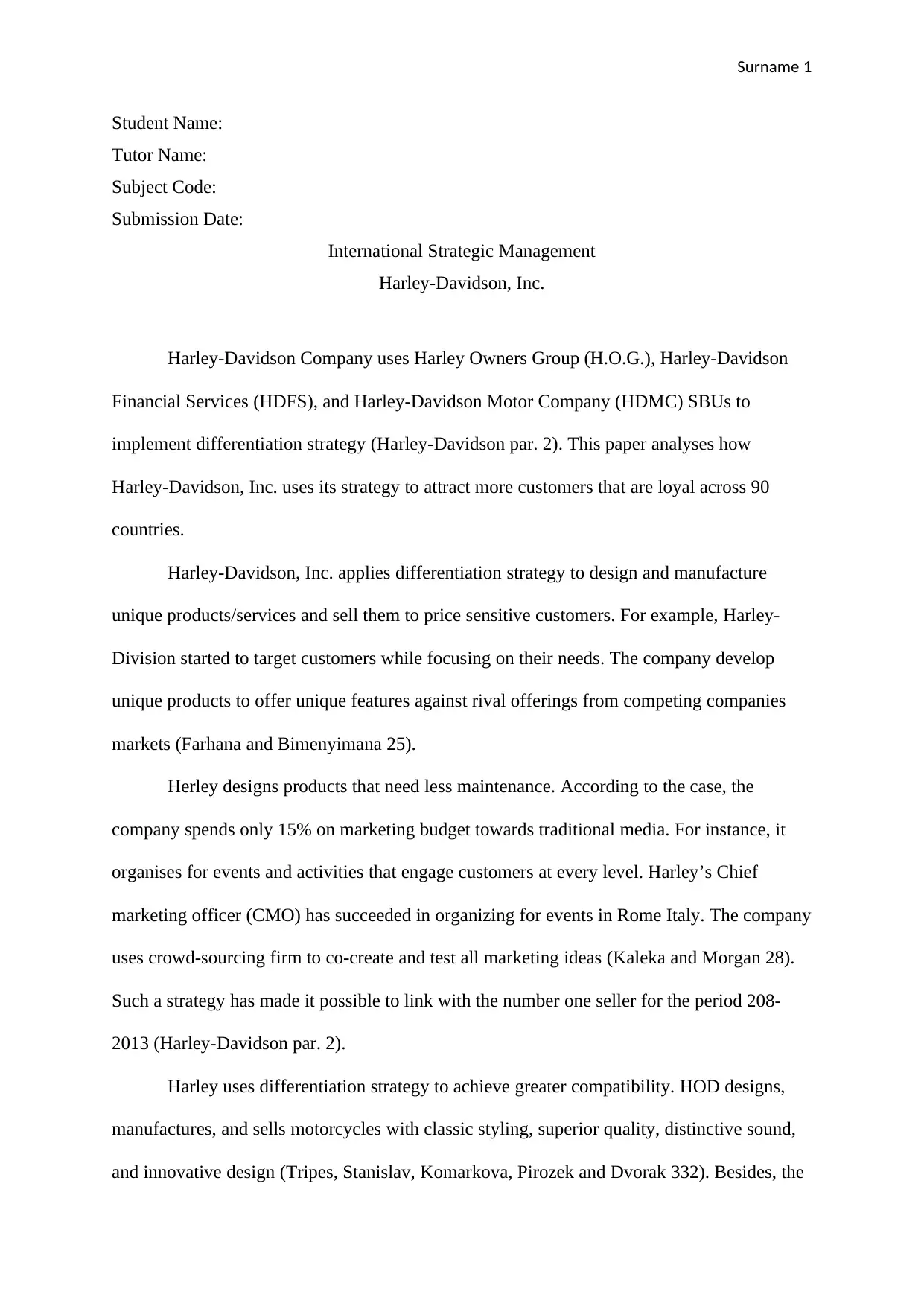
Surname 1
Student Name:
Tutor Name:
Subject Code:
Submission Date:
International Strategic Management
Harley-Davidson, Inc.
Harley-Davidson Company uses Harley Owners Group (H.O.G.), Harley-Davidson
Financial Services (HDFS), and Harley-Davidson Motor Company (HDMC) SBUs to
implement differentiation strategy (Harley-Davidson par. 2). This paper analyses how
Harley-Davidson, Inc. uses its strategy to attract more customers that are loyal across 90
countries.
Harley-Davidson, Inc. applies differentiation strategy to design and manufacture
unique products/services and sell them to price sensitive customers. For example, Harley-
Division started to target customers while focusing on their needs. The company develop
unique products to offer unique features against rival offerings from competing companies
markets (Farhana and Bimenyimana 25).
Herley designs products that need less maintenance. According to the case, the
company spends only 15% on marketing budget towards traditional media. For instance, it
organises for events and activities that engage customers at every level. Harley’s Chief
marketing officer (CMO) has succeeded in organizing for events in Rome Italy. The company
uses crowd-sourcing firm to co-create and test all marketing ideas (Kaleka and Morgan 28).
Such a strategy has made it possible to link with the number one seller for the period 208-
2013 (Harley-Davidson par. 2).
Harley uses differentiation strategy to achieve greater compatibility. HOD designs,
manufactures, and sells motorcycles with classic styling, superior quality, distinctive sound,
and innovative design (Tripes, Stanislav, Komarkova, Pirozek and Dvorak 332). Besides, the
Student Name:
Tutor Name:
Subject Code:
Submission Date:
International Strategic Management
Harley-Davidson, Inc.
Harley-Davidson Company uses Harley Owners Group (H.O.G.), Harley-Davidson
Financial Services (HDFS), and Harley-Davidson Motor Company (HDMC) SBUs to
implement differentiation strategy (Harley-Davidson par. 2). This paper analyses how
Harley-Davidson, Inc. uses its strategy to attract more customers that are loyal across 90
countries.
Harley-Davidson, Inc. applies differentiation strategy to design and manufacture
unique products/services and sell them to price sensitive customers. For example, Harley-
Division started to target customers while focusing on their needs. The company develop
unique products to offer unique features against rival offerings from competing companies
markets (Farhana and Bimenyimana 25).
Herley designs products that need less maintenance. According to the case, the
company spends only 15% on marketing budget towards traditional media. For instance, it
organises for events and activities that engage customers at every level. Harley’s Chief
marketing officer (CMO) has succeeded in organizing for events in Rome Italy. The company
uses crowd-sourcing firm to co-create and test all marketing ideas (Kaleka and Morgan 28).
Such a strategy has made it possible to link with the number one seller for the period 208-
2013 (Harley-Davidson par. 2).
Harley uses differentiation strategy to achieve greater compatibility. HOD designs,
manufactures, and sells motorcycles with classic styling, superior quality, distinctive sound,
and innovative design (Tripes, Stanislav, Komarkova, Pirozek and Dvorak 332). Besides, the
Paraphrase This Document
Need a fresh take? Get an instant paraphrase of this document with our AI Paraphraser
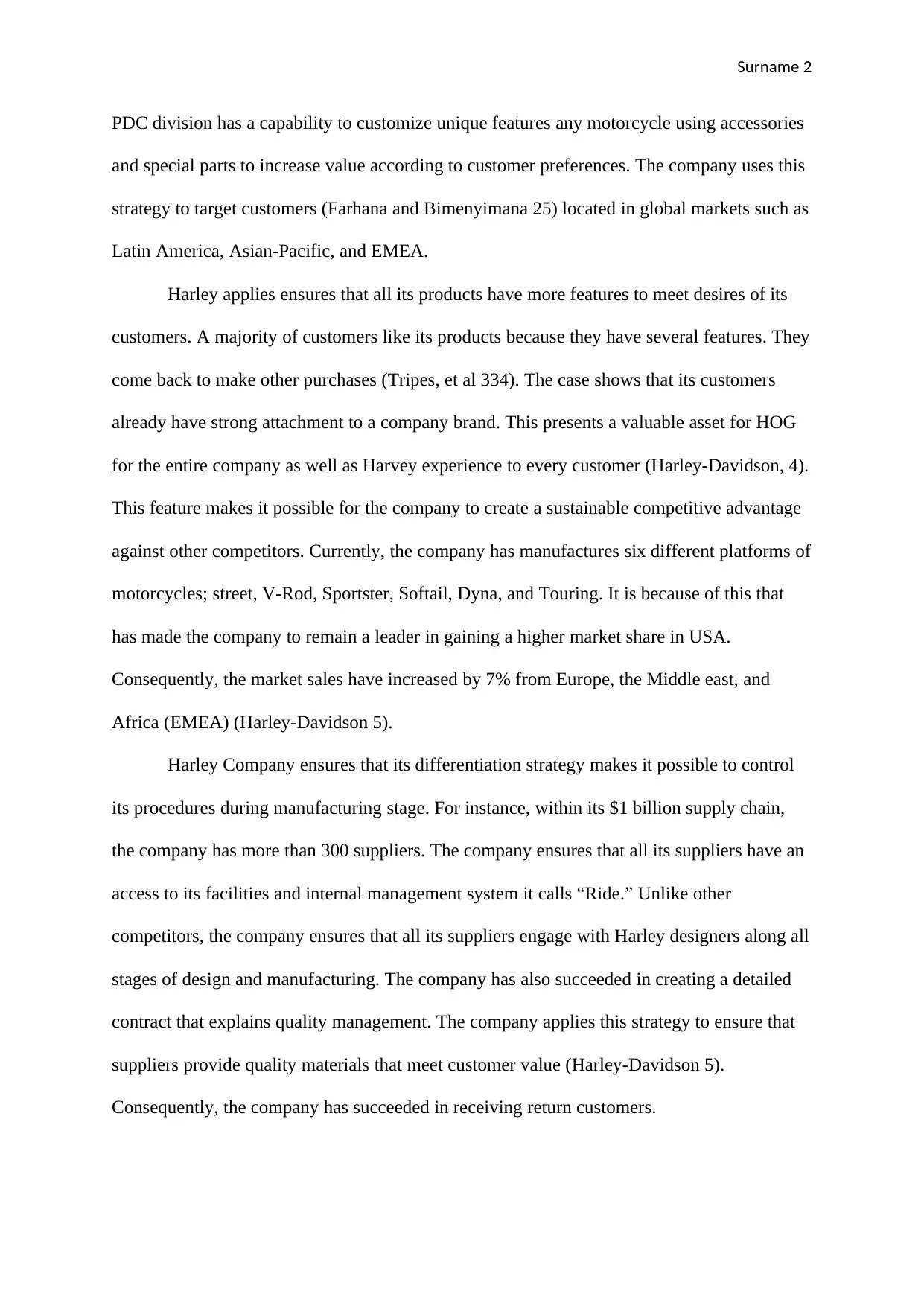
Surname 2
PDC division has a capability to customize unique features any motorcycle using accessories
and special parts to increase value according to customer preferences. The company uses this
strategy to target customers (Farhana and Bimenyimana 25) located in global markets such as
Latin America, Asian-Pacific, and EMEA.
Harley applies ensures that all its products have more features to meet desires of its
customers. A majority of customers like its products because they have several features. They
come back to make other purchases (Tripes, et al 334). The case shows that its customers
already have strong attachment to a company brand. This presents a valuable asset for HOG
for the entire company as well as Harvey experience to every customer (Harley-Davidson, 4).
This feature makes it possible for the company to create a sustainable competitive advantage
against other competitors. Currently, the company has manufactures six different platforms of
motorcycles; street, V-Rod, Sportster, Softail, Dyna, and Touring. It is because of this that
has made the company to remain a leader in gaining a higher market share in USA.
Consequently, the market sales have increased by 7% from Europe, the Middle east, and
Africa (EMEA) (Harley-Davidson 5).
Harley Company ensures that its differentiation strategy makes it possible to control
its procedures during manufacturing stage. For instance, within its $1 billion supply chain,
the company has more than 300 suppliers. The company ensures that all its suppliers have an
access to its facilities and internal management system it calls “Ride.” Unlike other
competitors, the company ensures that all its suppliers engage with Harley designers along all
stages of design and manufacturing. The company has also succeeded in creating a detailed
contract that explains quality management. The company applies this strategy to ensure that
suppliers provide quality materials that meet customer value (Harley-Davidson 5).
Consequently, the company has succeeded in receiving return customers.
PDC division has a capability to customize unique features any motorcycle using accessories
and special parts to increase value according to customer preferences. The company uses this
strategy to target customers (Farhana and Bimenyimana 25) located in global markets such as
Latin America, Asian-Pacific, and EMEA.
Harley applies ensures that all its products have more features to meet desires of its
customers. A majority of customers like its products because they have several features. They
come back to make other purchases (Tripes, et al 334). The case shows that its customers
already have strong attachment to a company brand. This presents a valuable asset for HOG
for the entire company as well as Harvey experience to every customer (Harley-Davidson, 4).
This feature makes it possible for the company to create a sustainable competitive advantage
against other competitors. Currently, the company has manufactures six different platforms of
motorcycles; street, V-Rod, Sportster, Softail, Dyna, and Touring. It is because of this that
has made the company to remain a leader in gaining a higher market share in USA.
Consequently, the market sales have increased by 7% from Europe, the Middle east, and
Africa (EMEA) (Harley-Davidson 5).
Harley Company ensures that its differentiation strategy makes it possible to control
its procedures during manufacturing stage. For instance, within its $1 billion supply chain,
the company has more than 300 suppliers. The company ensures that all its suppliers have an
access to its facilities and internal management system it calls “Ride.” Unlike other
competitors, the company ensures that all its suppliers engage with Harley designers along all
stages of design and manufacturing. The company has also succeeded in creating a detailed
contract that explains quality management. The company applies this strategy to ensure that
suppliers provide quality materials that meet customer value (Harley-Davidson 5).
Consequently, the company has succeeded in receiving return customers.
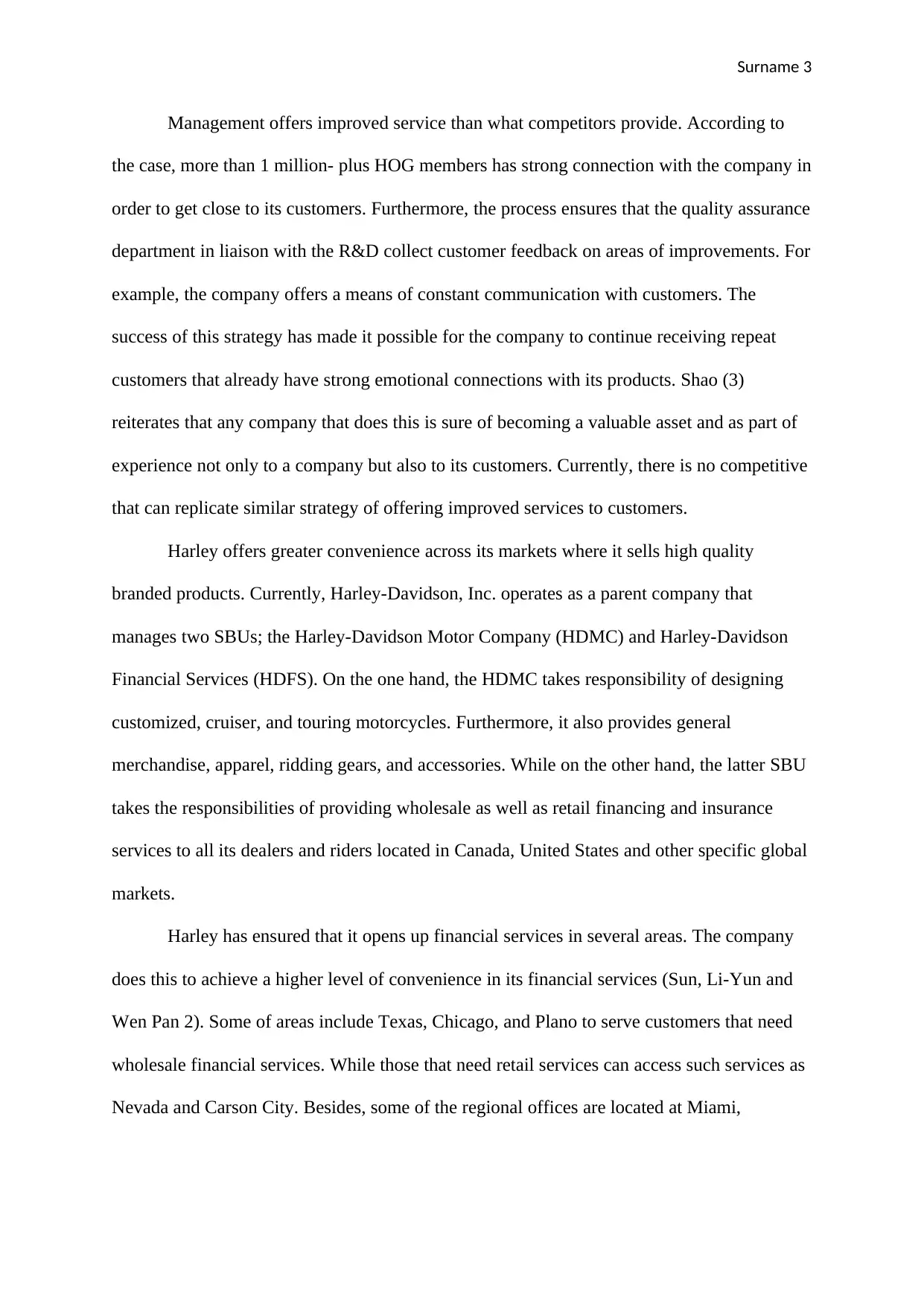
Surname 3
Management offers improved service than what competitors provide. According to
the case, more than 1 million- plus HOG members has strong connection with the company in
order to get close to its customers. Furthermore, the process ensures that the quality assurance
department in liaison with the R&D collect customer feedback on areas of improvements. For
example, the company offers a means of constant communication with customers. The
success of this strategy has made it possible for the company to continue receiving repeat
customers that already have strong emotional connections with its products. Shao (3)
reiterates that any company that does this is sure of becoming a valuable asset and as part of
experience not only to a company but also to its customers. Currently, there is no competitive
that can replicate similar strategy of offering improved services to customers.
Harley offers greater convenience across its markets where it sells high quality
branded products. Currently, Harley-Davidson, Inc. operates as a parent company that
manages two SBUs; the Harley-Davidson Motor Company (HDMC) and Harley-Davidson
Financial Services (HDFS). On the one hand, the HDMC takes responsibility of designing
customized, cruiser, and touring motorcycles. Furthermore, it also provides general
merchandise, apparel, ridding gears, and accessories. While on the other hand, the latter SBU
takes the responsibilities of providing wholesale as well as retail financing and insurance
services to all its dealers and riders located in Canada, United States and other specific global
markets.
Harley has ensured that it opens up financial services in several areas. The company
does this to achieve a higher level of convenience in its financial services (Sun, Li-Yun and
Wen Pan 2). Some of areas include Texas, Chicago, and Plano to serve customers that need
wholesale financial services. While those that need retail services can access such services as
Nevada and Carson City. Besides, some of the regional offices are located at Miami,
Management offers improved service than what competitors provide. According to
the case, more than 1 million- plus HOG members has strong connection with the company in
order to get close to its customers. Furthermore, the process ensures that the quality assurance
department in liaison with the R&D collect customer feedback on areas of improvements. For
example, the company offers a means of constant communication with customers. The
success of this strategy has made it possible for the company to continue receiving repeat
customers that already have strong emotional connections with its products. Shao (3)
reiterates that any company that does this is sure of becoming a valuable asset and as part of
experience not only to a company but also to its customers. Currently, there is no competitive
that can replicate similar strategy of offering improved services to customers.
Harley offers greater convenience across its markets where it sells high quality
branded products. Currently, Harley-Davidson, Inc. operates as a parent company that
manages two SBUs; the Harley-Davidson Motor Company (HDMC) and Harley-Davidson
Financial Services (HDFS). On the one hand, the HDMC takes responsibility of designing
customized, cruiser, and touring motorcycles. Furthermore, it also provides general
merchandise, apparel, ridding gears, and accessories. While on the other hand, the latter SBU
takes the responsibilities of providing wholesale as well as retail financing and insurance
services to all its dealers and riders located in Canada, United States and other specific global
markets.
Harley has ensured that it opens up financial services in several areas. The company
does this to achieve a higher level of convenience in its financial services (Sun, Li-Yun and
Wen Pan 2). Some of areas include Texas, Chicago, and Plano to serve customers that need
wholesale financial services. While those that need retail services can access such services as
Nevada and Carson City. Besides, some of the regional offices are located at Miami,
⊘ This is a preview!⊘
Do you want full access?
Subscribe today to unlock all pages.

Trusted by 1+ million students worldwide
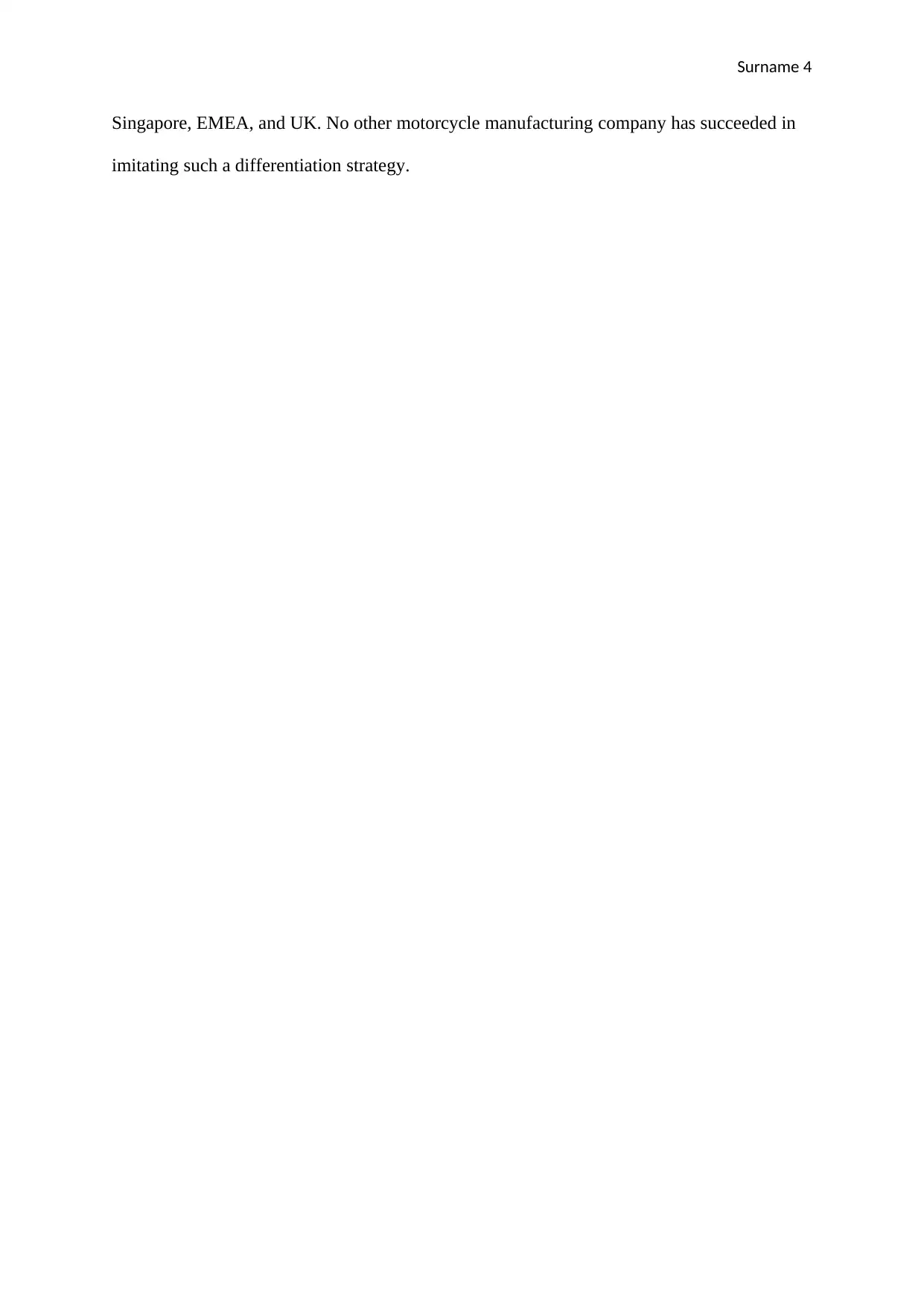
Surname 4
Singapore, EMEA, and UK. No other motorcycle manufacturing company has succeeded in
imitating such a differentiation strategy.
Singapore, EMEA, and UK. No other motorcycle manufacturing company has succeeded in
imitating such a differentiation strategy.
Paraphrase This Document
Need a fresh take? Get an instant paraphrase of this document with our AI Paraphraser
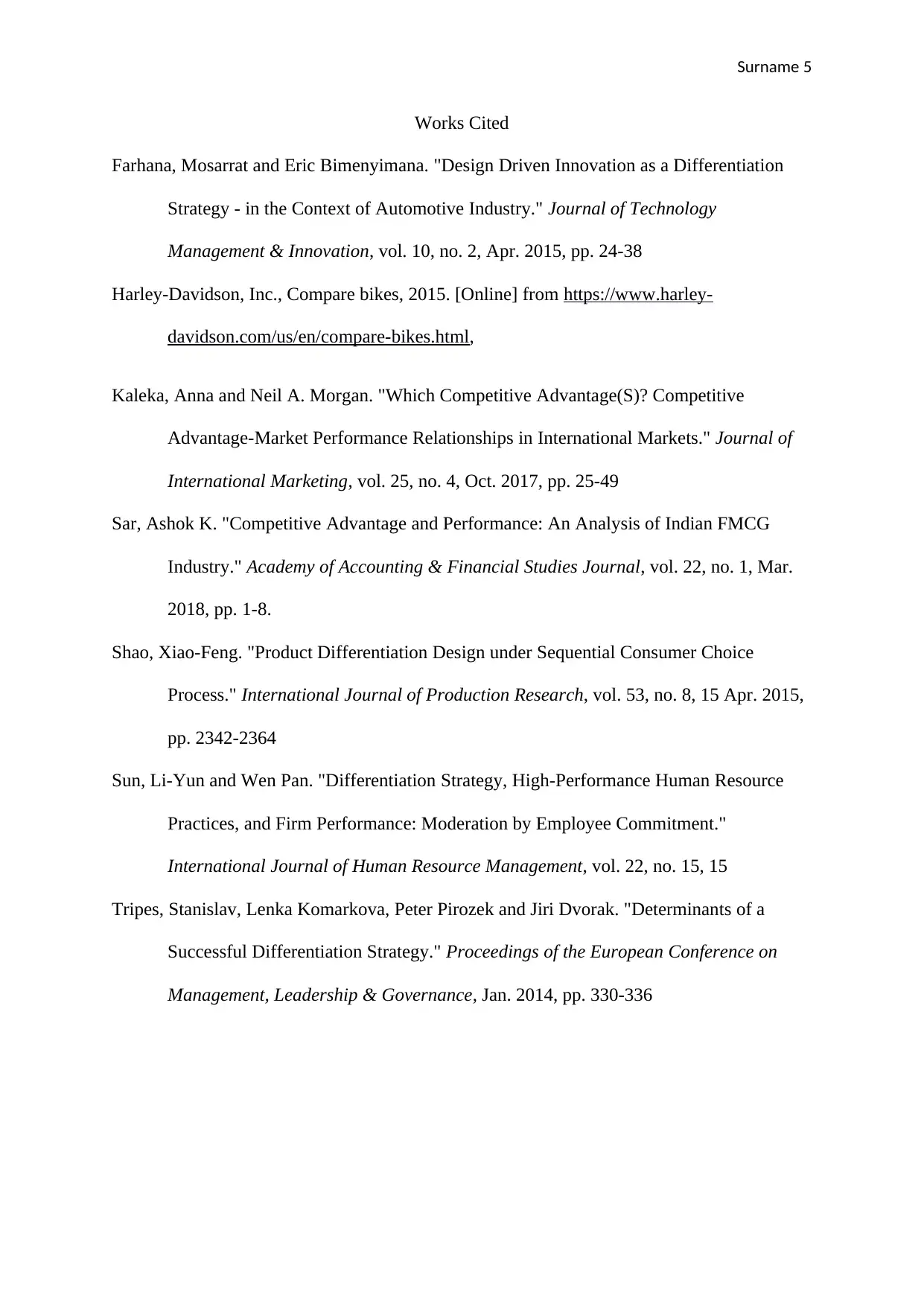
Surname 5
Works Cited
Farhana, Mosarrat and Eric Bimenyimana. "Design Driven Innovation as a Differentiation
Strategy - in the Context of Automotive Industry." Journal of Technology
Management & Innovation, vol. 10, no. 2, Apr. 2015, pp. 24-38
Harley-Davidson, Inc., Compare bikes, 2015. [Online] from https://www.harley-
davidson.com/us/en/compare-bikes.html,
Kaleka, Anna and Neil A. Morgan. "Which Competitive Advantage(S)? Competitive
Advantage-Market Performance Relationships in International Markets." Journal of
International Marketing, vol. 25, no. 4, Oct. 2017, pp. 25-49
Sar, Ashok K. "Competitive Advantage and Performance: An Analysis of Indian FMCG
Industry." Academy of Accounting & Financial Studies Journal, vol. 22, no. 1, Mar.
2018, pp. 1-8.
Shao, Xiao-Feng. "Product Differentiation Design under Sequential Consumer Choice
Process." International Journal of Production Research, vol. 53, no. 8, 15 Apr. 2015,
pp. 2342-2364
Sun, Li-Yun and Wen Pan. "Differentiation Strategy, High-Performance Human Resource
Practices, and Firm Performance: Moderation by Employee Commitment."
International Journal of Human Resource Management, vol. 22, no. 15, 15
Tripes, Stanislav, Lenka Komarkova, Peter Pirozek and Jiri Dvorak. "Determinants of a
Successful Differentiation Strategy." Proceedings of the European Conference on
Management, Leadership & Governance, Jan. 2014, pp. 330-336
Works Cited
Farhana, Mosarrat and Eric Bimenyimana. "Design Driven Innovation as a Differentiation
Strategy - in the Context of Automotive Industry." Journal of Technology
Management & Innovation, vol. 10, no. 2, Apr. 2015, pp. 24-38
Harley-Davidson, Inc., Compare bikes, 2015. [Online] from https://www.harley-
davidson.com/us/en/compare-bikes.html,
Kaleka, Anna and Neil A. Morgan. "Which Competitive Advantage(S)? Competitive
Advantage-Market Performance Relationships in International Markets." Journal of
International Marketing, vol. 25, no. 4, Oct. 2017, pp. 25-49
Sar, Ashok K. "Competitive Advantage and Performance: An Analysis of Indian FMCG
Industry." Academy of Accounting & Financial Studies Journal, vol. 22, no. 1, Mar.
2018, pp. 1-8.
Shao, Xiao-Feng. "Product Differentiation Design under Sequential Consumer Choice
Process." International Journal of Production Research, vol. 53, no. 8, 15 Apr. 2015,
pp. 2342-2364
Sun, Li-Yun and Wen Pan. "Differentiation Strategy, High-Performance Human Resource
Practices, and Firm Performance: Moderation by Employee Commitment."
International Journal of Human Resource Management, vol. 22, no. 15, 15
Tripes, Stanislav, Lenka Komarkova, Peter Pirozek and Jiri Dvorak. "Determinants of a
Successful Differentiation Strategy." Proceedings of the European Conference on
Management, Leadership & Governance, Jan. 2014, pp. 330-336
1 out of 5
Related Documents
Your All-in-One AI-Powered Toolkit for Academic Success.
+13062052269
info@desklib.com
Available 24*7 on WhatsApp / Email
![[object Object]](/_next/static/media/star-bottom.7253800d.svg)
Unlock your academic potential
Copyright © 2020–2025 A2Z Services. All Rights Reserved. Developed and managed by ZUCOL.




